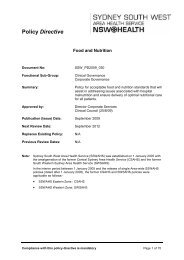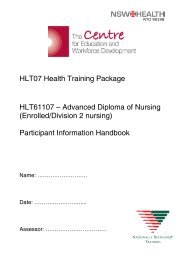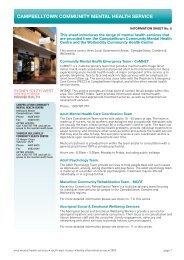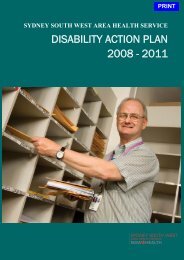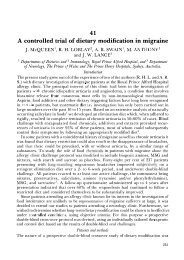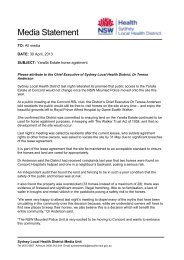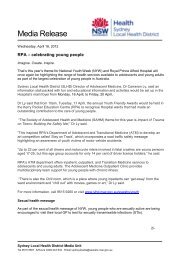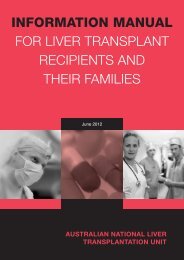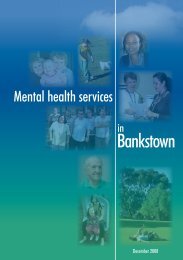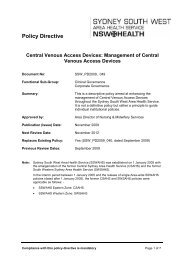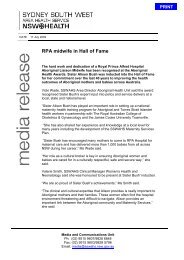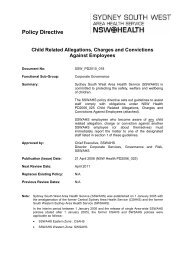Aged Care & Rehabilitation Clinical Services Plan 2007 – 2012
Aged Care & Rehabilitation Clinical Services Plan 2007 – 2012
Aged Care & Rehabilitation Clinical Services Plan 2007 – 2012
Create successful ePaper yourself
Turn your PDF publications into a flip-book with our unique Google optimized e-Paper software.
<strong>Aged</strong> <strong>Care</strong> & <strong>Rehabilitation</strong> <strong>Clinical</strong> Service <strong>Plan</strong> <strong>2007</strong> - <strong>2012</strong>• Supra-regional services – specialised services catering for a small number of people withspecific health needs. Such specialised services are to be concentrated on one site tofacilitate access to specialist expertise and equipment;• Partnership/Associated services – services providing extensive assistance to AC&RSclients and/or are operated cooperatively between AC&RS and other clinical services.This includes services provided by the non-government sector, such as community andresidential care.A service delivery system comprising core, supra-regional and partnership/associated servicesworking collaboratively, will ensure that a high quality, safe and comprehensive system of care isprovided to all AC&RS clients, at different stages within the lifecycle and disease progression.These services operate along a care continuum from community/residential care, the interfacebetween community and acute services, post-acute services and community/residential care (referFigure 5.2). <strong>Services</strong> are categorised as:• Community/Non-Inpatient <strong>Services</strong> – with a focus on prevention of illness, deteriorationand hospital admission; early intervention; post acute care; maintenance or support; and• Inpatient <strong>Services</strong> – provided in the inpatient setting – be it acute or sub-acute.As clients access AC&RS through multiple entry points along the continuum of care, this is anillustrative delineation only. AC&RS are delivered seamlessly to clients, and at a local level, servicemanagement is well integrated. Thus, a client may move between aged care and rehabilitationservices and other partnership/associated services, throughout their course of treatment.Implementation of the Service Delivery Model will be dependent on a range of factors. However,priority should be given to ensuring that the core services are available as outlined in this <strong>Plan</strong>.Supra-regional and partnership/associated services are also integral to the whole model of care. Ifthis model is implemented, clients will have timely access to appropriate services and there will bean associated reduction in unnecessary reliance on the acute setting, through implementation ofpreventative care models, early intervention systems and post discharge support.5.1 Core <strong>Services</strong>Core services are essential, evidence based services which should be provided across the Area toservice local catchments. It is proposed that these services be consolidated in facilities which haveadequate and appropriate back-up support, and in which the critical mass necessary to provide aquality service can be obtained. The Core Service Delivery Model is discussed in detail in Section 6.Extensive literature outlines the benefits of core evidence based services, including reducedmortality, improved function and cognition, reduction in adverse events, improved quality of life, andgains in efficiency such as a reduction in hospitalisation, length of stay and health care costs.A range of professionals (including medical, nursing and allied health staff) provide these services incommunity, residential and acute settings. They are designed to be complementary with stronglinkages between the various service settings, to ensure continuity of care, regardless of the serviceprovider. Table 5.1 lists core services according to service category.Table 5.1 Core SSWAHS AC&RS by Service CategoryService Category Service TypeCommunity / • Centralised intakeNon-Inpatient • <strong>Aged</strong> <strong>Care</strong> Assessment Teams (ACAT)(preventative, earlyintervention, post• <strong>Aged</strong>care <strong>Services</strong> in Emergency Teams(ASET)acute care,• Outpatient Clinics – Geriatric andmaintenance and <strong>Rehabilitation</strong>support)• Day Hospitals and Outpatient TherapyPage 31• ComPacks• Transitional <strong>Aged</strong> <strong>Care</strong> Program• Community Dementia Teams• Centre Based Day <strong>Care</strong>• Dementia Advisory <strong>Services</strong>• Respite and Support <strong>Services</strong>• Home Based TherapyInpatient <strong>Services</strong> • Acute, Sub-Acute <strong>Aged</strong> <strong>Care</strong> & <strong>Rehabilitation</strong> Units (including dementia/delirium units)• Inpatient Geriatric/Dementia Consultation• Inpatient <strong>Rehabilitation</strong> Consultation• Dementia and Gerontology <strong>Clinical</strong> Nurse ConsultantsCore services operate within a continuum of care represented in the figure following.




